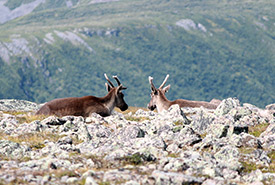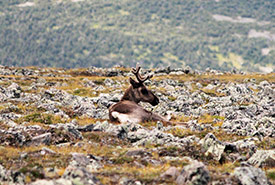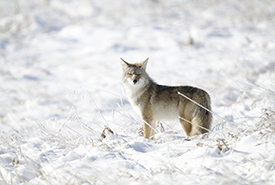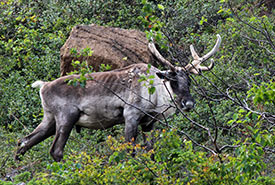Antlers of the East: Tracking the decline of the Atlantic-Gaspésie caribou (part two)

Woodland caribou at the summit of Mont Jacques-Cartier, tallest among the Chic Choc Mountains of Gaspésie National Park, QC. (Photo by Zack Metcalfe)
In part one of Antlers of the East, I discussed the decline of the Atlantic-Gaspésie caribou. Here is part two.
Stand against extinction
Since 2008, the caribou of Gaspésie National Park have been under the thoughtful study of biologist Martin-Hugues St-Laurent, PhD, with the Université du Québec à Rimouski.
He collected the necessary funds to launch this endeavour, the most intensive research program for caribou in all of Eastern Canada. With the knowledge he gained from careful observation, as well as a telemetry monitoring program, he’s come to appreciate the true nature of our surviving Atlantic-Gaspésie caribou, the factors causing their continued decline and, importantly, how they might be saved.
Martin-Hugues said this population of caribou consists of three separate groups: those holding Mont Logan to the west, Mont Albert in the park’s centre and Mont McGerrigles to the east, and the last encompassing Mont Jacques-Cartier. Incredibly, there is still enough genetic diversity among these small groups to allow for their long-term survival. So the barriers to recovery are not within, but without.
Like its Maritime counterparts, the Gaspé Peninsula has hosted decades of intensive logging, trading its mature forest stands for a younger, thinner, less productive landscape better suited for non-native species, such as coyote. This prolific predator began its invasion of the Gaspé Peninsula 45 years ago, explained Martin-Hugues, and has crowded more and more tightly around Gaspésie National Park, along with forestry. Coyotes do a lot better in disturbed and human-dominated environments. They are more comfortable with people around and in young bush. Caribou, on the other hand, depend on mature habitat flush with lichen, one of their primary food sources. Mature forest stands within 30 kilometres of the park, for example, have been reduced by half since 1989. The Atlantic-Gaspésie caribou continue to decline because of this predator’s incursions into the park, preying upon their young.

Woodland caribou at the summit of Mont Jacques-Cartier, tallest among the Chic Choc Mountains of Gaspésie National Park, QC. (Photo by Zack Metcalfe)
“So we have this huge contrast between this island of suitable habitat for caribou within the park and a sea of cut blocks beyond,” said Martin-Hugues. "Visitors don’t need signage to know when they’ve left the park; the sudden shortness of trees speaks volumes."
"We’re facing extirpation,” he said. “If we don’t do anything, we’ll probably lose the Atlantic-Gaspésie caribou in 50 years.”
Such was the conclusion of a population viability analysis conducted by Martin-Hugues and his colleagues. An obvious solution is to limit the amount of logging on the peninsula, allowing its forests to mature and exchange coyote habitat for that of the caribou. Unfortunately, the decades necessary for this regrowth would be too long of a wait for these struggling caribou.
If the population is to survive, said Martin-Hugues, reductions in regional cutting must come hand in hand with significant increases in predator control: the removal of 25 per cent of the peninsula’s coyotes. It’s a substantial undertaking, he freely admits, but the uptake in suitable caribou habitat together with decreased predation would tip the balance in favour of this endangered species, allowing not only for their recovery, but their sustainable spread across the peninsula. It’s a plan he brought to the attention of Quebec’s provincial government in the winter of 2017, as well as to Sépaq, the society responsible for the management of this park and others across the province.

Coyote (Photo by Paul Turbitt)
Mandatory optimism
When I finally saw these caribou atop Mont Jacques-Cartier, there was enough history behind them to leave me awestruck of this otherwise humble creature. In that first encounter, there were only five passing the morning on Gaspésie’s highest peak.
Days later I scaled Mont Albert, which alternates between wide, well groomed trails and natural, narrow stone staircases. Its peak defies expectations, with its 20 km2 plateau of golden grasslands reminiscent of the Canadian prairies. A wooden walkway brought me along, interrupted by a herd of perhaps two dozen caribou crossing just in front.
The walkway leads to a breathtaking valley that flows from this mountain’s far side, and marked by a river and its tumbling descent. Near its bank I met my last caribou, a male sporting modest antlers as it grazed on shrubs. It was an elegant and handsome creature, one that would be a privilege to once again support in the Maritimes. It’s exactly this sort of encounter, and this brand of admiration, Martin-Hugues is counting on to save the population.

A male woodland caribou on the slopes of Mont Albert, among the Chic Choc Mountains of Gaspésie National Park, QC. (Photo by Zack Metcalfe)
He puts his faith in Canadians and the groundswell they might make possible on behalf of his caribou. Local communities are not blind to the eco-tourism these caribou attract, as well as the intrinsic value of intact natural heritage. And visitors, such as myself, are often overwhelmed by the majesty of Gaspésie National Park. In this way, he hopes for the public support these caribou desperately need. Donating to conservation efforts and seeing the Atlantic-Gaspésie caribou in person are contributions as meaningful as any.
“Some forestry industries would like to see me as a caribou lover,” said Martin-Hugues, “but I’m not. I’m a scientist, and for me, we have a chance at success in the recovery of an endangered population that has been pushed into this situation because of human actions. It’s a wish I have, to be able to bring my kids to see these caribou in 20 years.”
I asked if there was cause to be optimistic and was surprised with his swift affirmative.
“If guys like me, working with these caribou, are not optimistic, who will be?”
This article was originally published in Rural Delivery Magazine.


